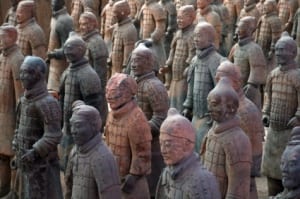
One of the most infamous emperors of Chinese antiquity was the very first: Qin Shi Huang.
Also known as Ying Zheng, he ruled the Chinese state of Qin from 247-210 BC. When he came to power, various Chinese kingdoms were engaged in a struggle against each other for superiority; by the time he died in 210 BC, he had managed to unify these warring states, becoming the First Emperor of China and ushering in the Qin Dynasty.
The Great Wall
Under the rule of Qin Shi Huang, massive construction projects were undertaken to help build the infrastructure needed in imperial China, often at the expense of many lives.
The first version of the Great Wall of China was built during this period, as was the first national road system.
A Mausoleum
But the most famous remnant of Qin Shi Huang’s rule was his mausoleum in the Shaanxi province of central China.
Construction began in 246 BC – in addition to the tomb that would house the body of the emperor, there were large palaces, valuables, rivers flowing with mercury, and scenes of the earth and sky painted on the ceiling.
An Army of Clay
But the most spectacular feature of the mausoleum was the emperor’s guards: the Terracotta Army. These 8,000 soldiers, crafted using molds and clay, stand guard over the Emperor Qin’s tomb so they may aid him in the afterlife.
The construction of the mausoleum, like other construction projects during the emperor’s rule, involved a huge workforce. An estimated 700,000 workers were involved in the mausoleum construction alone.
Who Built the Terracotta Army
Until now the identity of these workers has remained a mystery, but a study published last week in PLoS ONE has attempted to discover who these workers were by examining the DNA preserved in their bones.
In 2003, hundreds of skeletal remains were unearthed near the mausoleum. They were believed to be the remains of the workers who built the monument, and a preliminary examination of their bones revealed that these men were engaged in heavy manual labor up to their death. But due to poor preservation of the remains, scientists could not determine the ethnic origins of these workers. Since the Qin Dynasty controlled a vast territory and encompassed 22 million people, these workers could have come from anywhere.
Follow the Mito
So Chinese scientists decided to examine the mitochondrial DNA of these workers directly to discover their ethnic origins.
These scientists started by collecting DNA samples from 50 thigh bones for analysis. Because ancient DNA analysis is prone to contamination, the researchers took extreme precautions in performing their analysis. In the end, the state of decay of the samples meant the DNA of only 19 individuals could be analyzed.
What the researchers found was that these workers had come from a variety of places across East Asia. In fact, the 19 individuals fell into 16 unique maternal haplogroups. The most common haplogroup was N9a, which is thinly spread throughout central and eastern Asia today. Other maternal haplogroups represented included M8a, A, and D5, which are all present among East Asian populations today.
Origins
Only four of the 19 specimens could be considered ethnically Han, which is the most common ethnic group in China today. Interestingly, seven individuals came from southern China, and a smaller number came from northern China. One individual even carried the maternal haplogroup usually seen only among certain Japanese populations, M7a.
The authors conclude that the overall diversity of mitochondrial genetic types seen in these 19 individuals indicates that workers were taken from across China, something that is also asserted in historical records from the period. While further analysis of a greater number of remains is necessary, this initial study has shown that workers from all parts of the burgeoning Qin Empire may have taken part in building some of the first structures of Imperial China.



